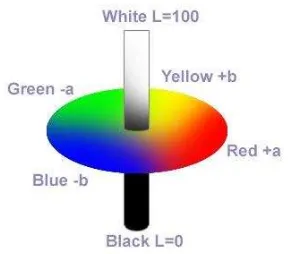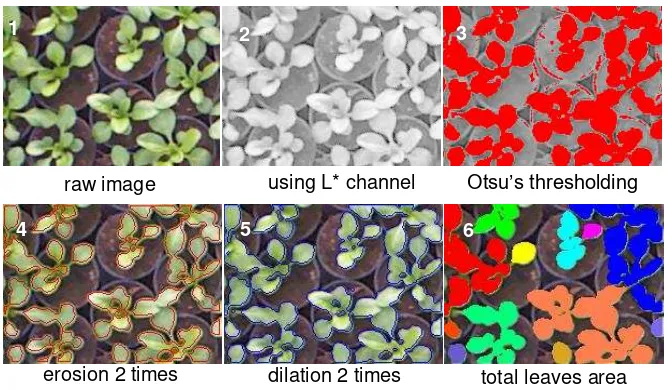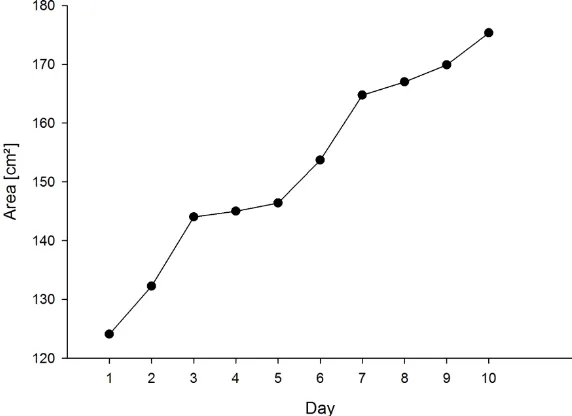58
Non-Destructive Measurement for Estimating Leaf Area of Bellis perennis Indera Sakti Nasution1*)
1)
Department of Agricultural Engineering, Syiah Kuala University, Indonesia *Email: [email protected]
Abstract
Non-destructive measurement of approaches of modeling can be very convenient and useful for plant growth estimation. This study, digital image processing was evaluated as a non-destructive technique to estimate leaf area of Bellis perennis. The plant samples were growing in the greenhouse and the images were taken every day using Kinect camera. The proposed method used combination of L*a*b* color space, Otsu’s thresholding, morphological operations and connected component analysis to estimate leaf area of Bellis perennis. L* channel was used to distinguish the leaves and background. Calibration area uses a pot of known area in each image as a scale to calibrate the leaves area. The results show that the algorithm is able to separate leaf pixels from soil or pot backgrounds, and also allowitto be implementedin greenhouse automatically. This algorithm can be used for other plants in assumption that there is not too much leaf overlapped during measurement.
Keywords: non-destructive, image processing, Bellis perennis, leaf area
Pengukuran Secara Tidak Merusak Untuk Menentukan Luas Daun Tanaman Bellis Perennis
Indera Sakti Nasution1*)
1)
Program Studi Teknik Pertanian, Universitas Syiah Kuala, Indonesia *Email: [email protected]
Abstrak
Pengukuran secara tidak merusak merupakan salah satu pendekatan modeling yang tepat dan berguna untuk menentukan pertumbuhan tanaman. Pada penelitian ini, pengolahan citra digital dievaluasi untuk menentukan luas daun tanaman Bellis perennis dengan menggunakan teknik tidak merusak (non-destructive). Sampel tanaman ditanam di dalam greenhouse dan diambil gambarnya setiap hari menggunakan kamera Kinect. Metode yang digunakan merupakan kombinasi antara ruang warna L*a*b*, metode Otsu, operasi morpologi, dan analisa komponen yang terkoneksi. Koordinat L* dipilih untuk membedakan antara daun dengan latar belakang. Kalibrasi luas daun menggunakan luas pot yang sudah diketahui sebelumnya. Berdasarkan hasil yang diperoleh, algoritma yang digunakan mampu memisahkan piksel-piksel daun dari latar belakang (tanah maupun pot tanaman), selain itu algoritma ini dapat diaplikasikan di dalam greenhouse secara otomatis. Algoritma ini juga dapat digunakan untuk tanaman yang lain, dengan asumsi bahwa overlapping antara daun tidak terlalu banyak.
Kata kunci : tidak merusak, citra digital, Bellis perennis, luas daun
JURNAL RONA TEKNIK PERTANIAN ISSN : 2085-2614; e-ISSN 2528 2654
59
1. Introduction
Leaf area plays an important role in photosynthesis, water and nutrient use,light
interception, yield potential and crop growth(Aase, 1978; Smart, 1985; Williams,
1987).Arapid, accurate and non-destructive method for the estimation of leaf area may be
useful to predict the relationship between leaf area and plant growth rate (Gamiely et al.,
1991; Montero et al., 2000). In order to monitor continuous changes in leaf area and the
subsequent growth, a modeling method is necessary. Simple regression models, related to
leaf area and cropgrowth ratehave been applied to estimate crop yields (Montero et al., 2000).
To estimate leaf area, variables, such as leaf length, leaf width, petiole length, or a
combination of these variables, were used (Montero et al., 2000; Williams III and Martinson,
2003). Since leaf development has correlation with crop growth, information about the
change in leaf area may be useful for estimating crop growth.
Considering that leaf area and crop growth are both affected by nutritional conditions,
more reliable results may be obtained through the addition of nutritional factors to the
models. For simple, rapid, and accurate estimation of leaf fresh, non-destructive and ease
tests, usingimage analysis is one of the alternative solutions. Leaf area based on image
analysis is eliminating the need for assessing measuring ruler manually. The objective of this
study was to develop method that capable of accurately estimating leaf areaof Bellis perennis
plant using digital image processing.
2. Materials and Methods
Bellis perennisimages were taken every day in greenhouse with a Kinect camera
(Xbox 360).The Kinect camera is an ultra-low cost vision sensor originally developed for
Microsoft Xbox 360. It combines an RGB camera (1280 * 1024, 15 frame per second (fps) or
640 * 480, 30 fps) with an IR structured light depth sensor (640 * 480, 30 fps). The RGB
camera has a 400 – 800 nm bandpass filter. The Kinect camera can be switched to near mode,
which provides a range of 500 – 3000 mm. However, in normal mode this system has a
minimum limit of 800 mm and a maximum limit of 4000 mm to work. Image processing
60
Fig. 1. Leaves area measurement steps
Converting the RGB image to the CIE-Lab color space avoids the lack of sensitivity
by increasing the accuracy of color segmentation. RGB color space has the disadvantage of
been very sensitive to the changes on lighting. Therefore,L*a*b*color space was
used.L*a*b* models was introduced in 1976 by the CIE (Commission Internationale de
l’éclairage) which is use in industrial applications. L* channel as luminance channel and two chrominance channels (a*–b*), which are defined as nonlinear transformations of the RGB
model. The aim is to gain a representation of color that is identical to the human perception.
The CIE-Lab (1976) color is organized as shown in Fig. 2.
Fig. 2. CIE-Lab colorspacestructure
RGB color space was converted to L*a*b* color space by the following set of
equations (MVtec, 2014):
(1)
Separating image into Red (R), Green (G), and Blue (B) channel
Converting RGB into L*a*b*
color spaces Choosing L* channel
Otsu’s thresholding Erosion 2 times
Dilation 2 times
Total leaves Area Intersection with
61
(2)
(3)
(4)
(5)
Where, are tristimulus of CIE-XYZ values with reference to the white spot.
(6)
Furthermore, individual image was identified by a thresholding procedure. Darker
region was taken to be an object of interest. In order to find the optimal thresholding value
between two peaks automatically, Otsu’s method was selected (Otsu, 1979). Otsu method is
established based on the optimal threshold that minimizing within-class variance which is
denoted as follows:
(7)
Where, w is the probability of occurrence of the two classes and is the variance values.
With the help of the morphological image processing operator erosion, it was possibleto
segment each of the single leaves. To return to the original size and structure of the leaves,
the eroded regions were iterativelyprocessed with dilation. Then, an intersection with the
original input region was performed. Total leaves area was measuredby following equation:
Leaves area = green leaves pixels count x (8)
Calibration area uses a pot of known area in each image as a scale to calibrate the leaves area.
3. Results and Discussion
Estimation of leaf area of Bellis perennis,was shown in Fig. 2. Successful
segmentation requires selection of an optimal threshold level. The optimal threshold gives the
best separation of the object and the background. After examining the channels individually
(data not shown), the choice of L* in L*a*b* color space found to be the optimal selection
62
between and background colors. Some studies have been used L*a*b* color space to separate
object from its background in horticultural products. L*a*b* is found to be the best color
space for plant and soil segmentation of lettuce (García-Mateos et al. (2015). Similar results
are supported by other researchers (Shih and Liu, 2005; Hernandez-Hernandez et al. 2016).
During individual image processing, pixelcounts and leaf areas images saved in
losslessTIFF format to provide a record of leaf area measurement and to facilitate
additionalanalyses. It can be observed that the automatic algorithm can be visuallyassessed
for any leaf image. Pixels identified as leaf area arerecolored for visual confirmation of leaf
detected.Connected component analysis identifies and labels connectedleaf pixels as separate
components (see different color in Fig. 2). Small and non-leaf components can be filtered out
if they were smaller than a user-selected minimum leaf size.
Fig. 2. Example of raw and processed image processing steps (top view)
Figure 3 shows continuous changes in leaf area due to subsequent growth which is
useful for estimating crop growth. The result was attributed to the fact that the plant leaves
growing every day and the single leaves were growing closer together and overlapped each
other. This measurement will be failed, if the leaves overlapped too much. Subsequently, the
use of morphological operations (erosion and dilation) to separate the components is failed.
The more complicated leaves is, the more difficult to isolate and to analyse individual leaves.
raw image using L* channel Otsu’s thresholding
erosion 2 times dilation 2 times total leaves area
1 2 3
63
Fig. 3. Result of leaf area of Bellis perennisselected using image processing
The real size of leaf area after calibratingwas shown in Fig. 4. The figure shows that
the leaf area of plant was slightly increased during the time. This information could be
necessary for prediction water and nutritional conditions, crop growth and yield potential. For
more precise algorithm, it was recommended individual leaf area could be validated with leaf
length and leaf width. Many studies have been carried out to estimate leaf area through
measuring leaf dimensions. In general, leaf length, leaf width, or combinations of these
variables have been used as parameters of leaf area models (Gamiely et al., 1991; Montero et
al., 2000; Williams III and Martinson, 2003).Moreover, other aspects should be added for
more precise modelling, such as: environmental factors and growth factors.
Fig. 4. Calculation of total leaves area using image processing on Bellis perennis every day
4. Conclusions
The algorithms proposean accurate method to estimate leaf area from digital images.
The algorithm able to separate leaf pixel from soil or pot backgrounds, and also allows itto be
implementedin greenhouse automatically. The algorithm uses the combination ofL*a*b*color
64
space, Otsu’s thresholding, morphological operations and connected component analysis.
This method will significantly increase rapidmeasurement of large plant collections. This
algorithm can be used for other plant in assumption that there is not too much leaf overlapped
during measurement. It is recommended forimproved accuracy of algorithm by validating
leaf area with some other factors, such as: leaf width, leaf length, environmental factors and
growth factors.
References
Aase, J.K.(1978). Relationship between leaf area and dry matter in winter wheat.Agron. J. 70, 563-565.
Gamiely, S., Randle, W.M., Mills, H.A., and Smittle, D.A.(1991). A rapid and nondestructive method for estimating leaf area of onions.HortScience 26 (2), 206.
García-Mateos, G., Hernández-Hernández, J.L., Escarabajal-Henarejos, D., Jaen-Terrones, S., and Molina-Martínez, J.M. (2015).Study and comparison of color models for automatic image analysis in irrigation management applications.Agric. Water Manage. 151, 158-166.
Hernández-Hernández, J.L., García-Mateos, G., González-Esquiva, J.M., Escarabajal-Henarejos, D., Ruiz-Canales, A., and Molina-Martínez, J.M. (2016).Optimal color space selection method for plant/soil segmentation in agriculture.Computers and Electronics in Agriculture, 122, 124-132.
Montero, F.J., de Juan, J.A., Cuesta, A., and Brasa, A.(2000).Nondestructive methods to estimate leaf area in Vitisvinifera L. HortScience, 35 (4),696-698.
MVTec Software GmbH. (2014).HALCON/HDevelop 12.0 Reference Manual, München, Germany.
Otsu, N. (1979). A Threshold Selection Method from Gray-Level Histogram.IEEE Trans. Systems Man, and Cybernetics, 9, 62-66.
Shih, P., and Liu, C. (2005).Comparative assessment of content-based face image retrieval in different color spaces.Audio and Video-Based Biometric Person Authentication, 3546, 1039-1048.
Smart, R.E.(1985). Principles of grapevine canopy microclimate manipulation with implications for yield and quality: a review. Am. J. Enol. Vitic. 36, 230-239.
Williams III, L. and Martinson, T.E.(2003).Non-destructive leaf area estimation of ‘Niagara’
and ‘De Chaunac’ grapevines. Sci. Hort. 98, 493-498.


